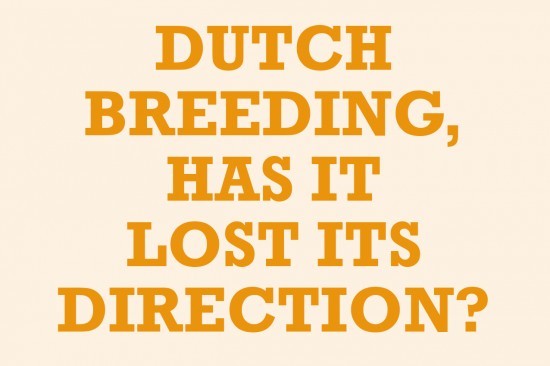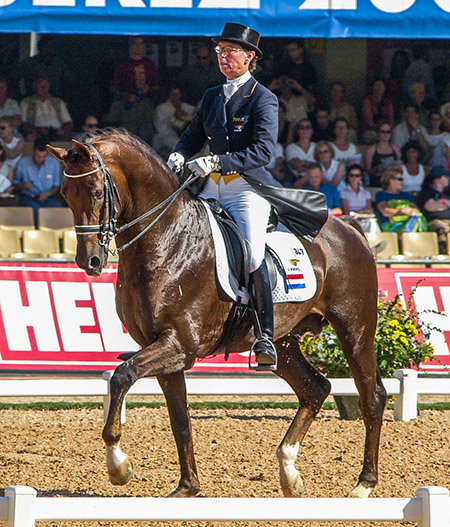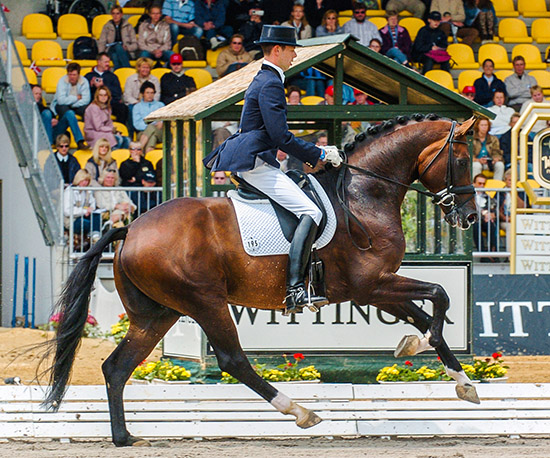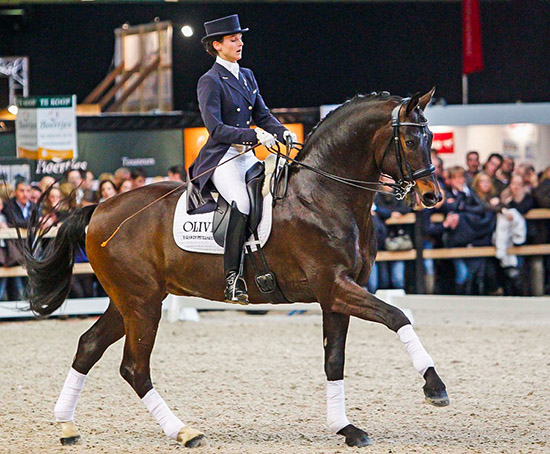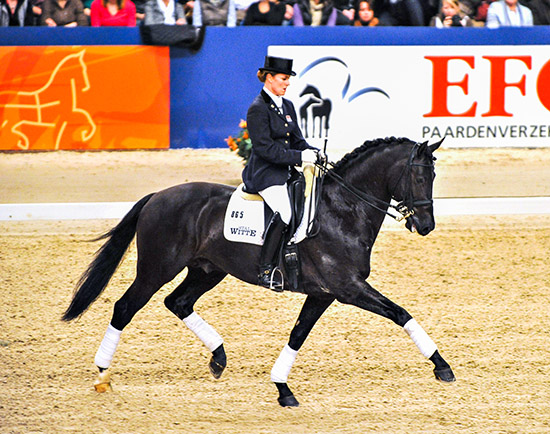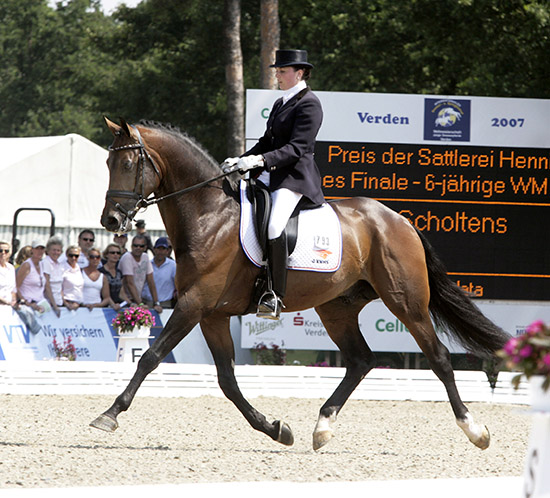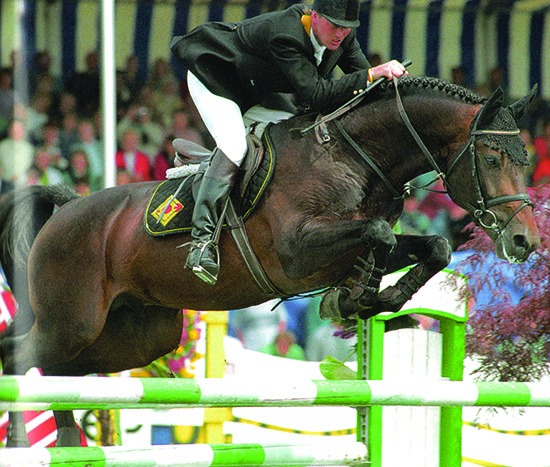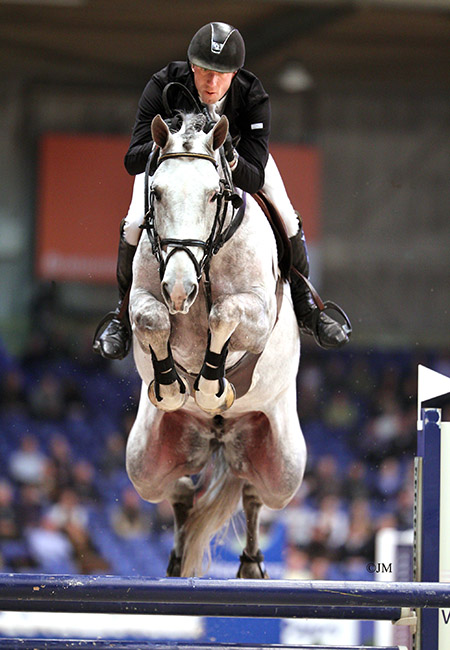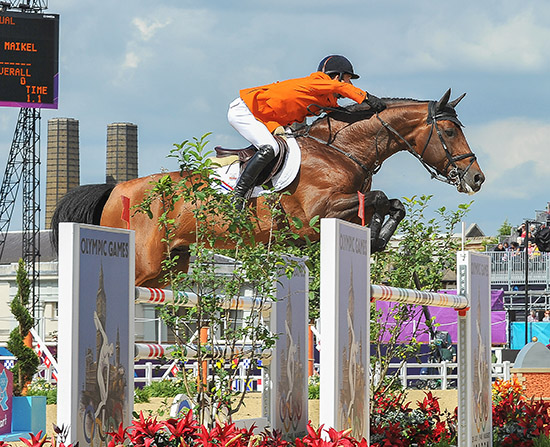By Christopher Hector
The rise and seemingly irresistible rise of the KWPN dressage contingent on the world stage has been squarely on the shoulders of a group of stallions who were themselves Grand Prix competitors. But now, the young ‘stars’ in the Dutch stallion lineup are failing to make it through to the international dressage ranks – are the Dutch about to lose the vital ingredient in their recipe for success? Let’s look at the recently released KWPN breeding values, and try to get a handle on what is happening…
On the 2012/2013 KWPN dressage stallions breeding values, it is no surprise to find that Jazz (Cocktail / Ulster) is once again top-of-the-pops with a breeding value of 194 and a reliability of 97. The Dutch values are now separated not by the age of the stallion’s competitors, as they have been in the past, but into the reliability rankings.
Jazz – No 1 again…
Thus Jazz heads the group of stallions with at least 10 offspring in dressage, and a reliability of 90 or more. He was also responsible for the most foals last season from this group of stallions – 100 – though he was far from the most used stallion in Holland, that honour goes to Charmeur (Florencio / Jazz) who put a staggering 301 foals on the ground last season.
However, while Jazz has the highest breeding value and reliability index, he certainly doesn’t have the best ‘strike rate’. Jazz’s evaluation is based on the performances of 770 dressage competitors – out of a progeny total of 2199 (that’s progeny over the age of four years old, not all progeny, we’re looking at the horses who would be competing, further references to progeny in this article refer to horses over the age of four) that’s 35%. The stallion with the best progeny-to-performer ratio in this group is the Weltmeyer son, Welt Hit II (Weltmeyer / Hill Hawk xx), with 266 competitors out of 636 progeny over four, that’s 41.8%.
Welt Hit II – the best strike rate…
Obviously the stallions in this group are the older ones, with more progeny, and a greater chance of a high reliability rating and right now there is nothing spectacular challenging Jazz for top spot. In fact the next six stallions after Jazz on the rankings – Contango (Contender / Kronprinz), Clavicimbel (Statuar / Apple King xx), Aktion (Pion / Akteur), Gribaldi (Kostolany / Ibikus), Welt Hit II and Havidoff (Clavicimbel / Farn), are all dead.
Negro (Ferro / Variant) is the next highest ranked with a value of 147 with a reliability of 93 – he produced 49 foals in 2012, no doubt influenced by Valegro’s starring performance at the 2010 Europeans in Rotterdam. His ‘strike rate’ is not wonderful, 268 out of 1027 (26%). Metall (Ferro / Ramiro), the sire of the other star on the British team, Uthopia, is further down the rankings on a breeding value of 126 (94 reliability) but he produced 46 foals last season, so it would seem that these two somewhat neglected sons of Ferro, may be getting their chance to prove their worth. Metall’s proportion of competitors to progeny is slightly better 342 out of 1113 – 30.7%.
Former world young horse champion, Florencio (Florestan / Weltmeyer) is in this group, in =12th, with a value of 140 (90 reliability) and 86 foals last season. He has a ratio of competitors to progeny of 28% (181 out of 641).
Florencio – stalled in the small tour
Florencio is another of a growing group of young Dutch dressage stallions, all of whom have set out on the path to the ‘big sport’ – Grand Prix competition – all of whom have fallen by the wayside, even though they have gone to good competition stables to further their career, in Florencio’s case (and for that matter, most of the others) those of Hans Peter Minderhoud. Florencio was second in the Prix St Georges at Aachen back in 2009, since then he has disappeared from the competition ring – while the horse that beat him in the Prix St Georges, Blind Date, recently carried Victoria Max-Theurer to victory in the Grand Prix at Bremen.
Florencio has produced almost 1000 foals in Holland alone, with his first crop in 2003, and with his largely German breeding, he has been popular in that country as well… he should have Small Tour horses on the ground by now…
The most obvious candidate to fly Florencio’s flag is Charmeur. I first saw Charmeur at the 2010 KWPN Stallion licensing, and thought him the best colt in the lineup. While he was not crowned the champion of the licensing, he went on to win the performance test, and the licensing champion seems to have disappeared without trace.
Charmeur – winners at medium level
At this year’s KWPN stallion show, Charmeur and Emmerlie Scholtens easily won the M-level Stallion championship. The trot was praised for its clear rhythm and uphill tendency. “Every step was right,” said the chairman of the Selection Committee, Arie Hamoen. “What else do you want to see? He gets a 10 from us.” The canter earned him a 9 and the walk went down to 7.5 as the stallion was a bit tense. Charmeur is too young to have a breeding value based on his progeny, although his value based on his own performance is right up there already, 175. It remains to be seen if he will go on and make it into Grand Prix ranks, and more importantly, produce progeny with the talent for the ‘big sport’.
Another ‘hot’ stallion in this group is Rousseau (Ferro / Roemer), who even though he moved to the United States soon after taking out reserve at the World Young Dressage horse five-year-old championships, continues to produce foals in Europe. He is another who has never competed after his young horse success, although it is claimed that he is ‘trained to Grand Prix’ – don’t you love those Grand Prix stars in the privacy of their own arenas? Rousseau ranks = 15th with a breeding value of 134 (91). In Holland he has sired 643 progeny over four years, for 219 competitors – 34.06%.
One of the most successful Jazz sons, Olivi
The second group of stallions – those with a reliability between 80–89%, is headed up by the Jazz son, Olivi (out of an Aktion mare). This horse was sold to the French stud, Haras du Feuillard, and competed in France from 2008 to 2010 at small tour level. He too has failed to make the leap to Grand Prix. As the late great Herbert Rehbein remarked: “It seems not so far from Prix St Georges to Grand Prix. The problem is that the Alps are in between.” Olivi has a breeding value of 173 (89) and a good strike rate – 30% (144 out of 480).
The next horse on the list is the eleven-year-old Vivaldi (Krack C / Jazz). This year his owner put an end to his competition career, and he was moved from Hans-Peter Minderhoud’s training stables to the Van Uytert stallion station, after he too failed to cross those Alps. In 2009 Vivaldi was the second most popular breeding stallion in The Netherlands with 285 mares. In 2011 Vivaldi only covered 33 mares, which I guess shows just how important success in the sport can be for a Dutch stallion. Vivaldi has a breeding value of 158 (82) and an appalling strike rate: 16% (61 out of 371).
In 6th place in this group we find Tango who on paper should be very much the real deal. He is by Jazz, the highest ranked stallion on the 90+ standings, out of a mare by the second placed stallion in this group, Contango. He was bred by the 2006 KWPN Breeder of the Year, Huub van Helvoirt, who also bred Jazz.
Tango has been trained to Grand Prix level by Hans Peter Minderhoud and soon after his Grand Prix debut, was winning classes. He collected two second place finishes in the Grand Prix and the Special at s’Hertogenbosch in 2011, and at Odense 2011 he won the Freestyle with 79.300%. And then…?
Since then the horse seems to have had tendon problems; he was scheduled to compete at s’Hertogenbosch in March, but was withdrawn.
Tango has a breeding value of 146 (84) – his strike rate is encouraging – 31.27% (86 out of 275).
In ninth we find another very popular stallion, Johnson (Jazz / Flemmingh), who sired 202 foals in the last season, which just goes to prove that the breeders are not always influenced by ‘the numbers’. Last year his breeding value was 146 (84), this year it is 139 (89). He has so far produced 773 progeny four years and old, with 149 competitors, a very modest 19.27%. Johnson should just be maturing into his Grand Prix career, but alas, even with the assistance of Hans Peter Minderhoud (no wonder he is so thin!) he has not made it out of the small tour.
Wynton, a winner at Bremen…
The next group of stallions, those with a reliability below 80, is headed by a stallion who last November came second in the Grand Prix of Bremen – Wynton (Jazz / Matador). The stallion scored 71.383, just behind Blind Date on 73.191, although the h0rse received mixed reviews from the cognizenti, with one pal whose eye I trust suggesting that “Wynton has no stretch in his body and no carrying hindleg.” Ten years old, Wynton has a breeding value of 183 (68), with 148 progeny over four, and 10 in competition, which is a 6.7% strike rate, although with the figures so low, this is probably meaningless. He sired 44 foals last season.
Very popular! Uphill
By far the most popular stallion in this group is Uphill (Oscar / Apollonios xx) who, despite languishing in 25th place with a breeding value of 133 (78) sired 143 foals. He has 47 competitors out of his 265 competition age progeny (17.7%). Uphill was born in 2001, and his best competition result so far is a Prix St Georges fourth, on a 70% score, in Denmark in January of this year…
Also in this group we find Voice (De Niro / Rohdiamant) once hailed as Edward Gal’s next star – and his similarity to Totilas was (briefly) remarked upon. At their first international show, the pair won the Prix St Georges at the 2011 CDI Zwolle. In second place that day were two unknowns, Charlotte Dujardin and an eight-year-old Valegro. Three years down the track, Valegro has a gold medal on his stable wall, and Voice, who has been out of the sport for a couple of years, is back in training with an unknown local trainer (she may be the next Charlotte!) Voice has a breeding value of 142 (71), with 205 progeny over four and 27 competitors – a hit rate of 13%. Still he had 84 foals last season.
Ampére – another that didn’t make it to Grand Prix
Ampère (Rousseau / Flemingh) once again dominated this year’s KWPN Licensing, with four of his colts going on to the performance test. Born in 2005, he has no four-year-olds yet, so his breeding value of 147 (59) is based on his personal performances… and once again, this is a worry since Ampère is another who has gone to a top rider / trainer, in this case, Jan Brink, but even though he is only eight, his career seems to have stalled, and he recently spent time at the Gerd Sosath station in Oldenburg, perhaps suggesting that he too has retired to the breeding barn.
Dutch journalist, Dirk Willem Rosie on his excellent website, horsesinternational.com, suggests that one possible reason for the failure of young stallions to make it through to Grand Prix, is that they are ‘burnt out’ by the time they have finished their Licensing. Under the heading ‘Child Abuse’, Dirk points out that the young stallions at the Danish licensing were required to perform four days in a row: in hand, on the lunge line, in free movement and under the saddle The ones awarded a premium had to return on Sunday at the end of the afternoon and the day after the licensing, the youngsters had to appear again, this time to start the ten-day character test, which is actually ten days of training under saddle! It is perhaps worth noting that Totilas did not take part in any licensing process… nor for that matter did Breitling, a Grand Prix performer currently breeding an extraordinary proportion of Grand Prix performers in Germany.
Having said that current German team star, Damon Hill, did the full-on circuit: licensing, two World Young Horse championships and steadily on to international success. It might just have helped that as a young horse he was guided by that most gifted and correct of trainers, Ingrid Klimke, and the ride was taken over by an Ingrid protégé, Helen Langehanenburg.
It must be a serious worry to the Dutch breeders. We have seen in Germany that the most successful dressage stallion of them all, Donnerhall, was himself a top Grand Prix competitor, and sired top Grand Prix competitor – stallion – sons, who have in turn sired Grand Prix performers. That was the recipe in Holland, Grand Prix producing Grand Prix, but suddenly now the wheels seem to have fallen off, just where are the young Grand Prix stallions who can take Dutch dressage breeding to the next level?
Dutch Jumping stallion breeding values – is the problem the same?
Looking at the jumping stallion ranks in Holland, it would seem that the mega star jumpers of previous years – like Libero H – are being replaced by horses with very modest performance records in the sport…
The group of older stallions with a reliability of 90 or more, is dominated by dead stallions, 12 out of the top 20 to be exact. The top stallion, Heartbreaker (Nimmerdor / Silvano) is 24 years old and his successful stud career has left him with a breeding value of 180 with a 95 reliability, this is easily the highest breeding value in any of the stallion groups. Heartbreaker has produced 907 progeny over four years old, but one foal in 2012 which might suggest his career is coming to an end. Of those 907, 335 have competed and contributed to his breeding value, that is a hit rate of 36.9% which is good but not so good as the horse in 3rd on the values, Libero H (Landgraf / Ronald) who had a staggering 250 competitors out of 573 progeny, that is 43.6%. Even the second ranked Hors La Loi II (Papillon Rouge / Joyau d’Or) has a better strike rate, 42.6% (162 out of 380).
Libero – just great
The only other stallion in this group with more than 100 mares is Numero Uno (Libero H / Lord Calando) with 175 foals in 2012. Numero Uno is ranked 8th in this group with a breeding value of 147 (96). He has 1329 over four, with 455 competing – that’s a strike rate of just over 34%. The next most popular stallion was Indoctro (Capitol I / Caletto II) with 132 foals and a 137 (98) breeding value. Indoctro has 3365 progeny over four, with 1210 in the sport. A strike rate of 35.95%.
Namelus R (Concorde / Joost) just misses out with 97 foals. He has a breeding value of 146 (92) and with 168 competitors out of 482 progeny, a strike rate of 34.85. While Heartbreaker, Numero Uno and Indoctro, all competed at Grand Prix level, Namelus R stalled at 1.30m.
We have to look at the second group of stallions, the ones with a reliability of 80 to 89, to see the new faces that are starting to make their mark. This group is headed up by the 12-year-old, Ustinov (Libero H / Nimmerdor). Ustinov was the licensing champion back in 2004, and rocketed to a 170 breeding value in 2011 but ominously, by 2013, the value has shrunk to 154 (87 reliability). Ustinov’s jumping career has been less than brilliant. In 2012, his best performances were a couple of placings in 1.35m speed classes at a two star CSI. His dam sire, Nimmerdor placed in international Grand Prix in his very short international career, while his sire, Libero H was a mega star, and won a string of World Cup qualifiers, including a World Cup final.
Ustinov’s strike rate is just 23.20% with 58 competitors out of 250 progeny over four years and so far there have been no stars in that group.
The next two horses on the list – Van Gogh and Warrant – are sons of Numero Uno (Libero H / Lord Calando) who ranks eighth in the 90+ group. Here we see the trend again: supersire father, Libero H, is followed by fairly average son. Numero Uno, even with Marco Kutscher in the saddle Numero Uno could do no better than a string of speed class places. His best placing was 1st in a 1.35m knock-out class at Zurich.
Van Gogh (out of a Bernstein mare and born 2002) is 2nd in the 80 to 89 group with a breeding value of 146 (84). He has competed in 1.60m classes and picked up placings in some minor GPs. His best placing was 2nd in the Grand Prix at the two star CSI in Roosendaal in a pretty second-rate lineup. Van Gogh has 27 competitors out of 236, strike rate of 11.44%.
The third ranked horse, Warrant (out of a Nimmerdor mare, and born in 2003), has so far had a modest competition career, his best a sixth in a rather third-rate Grand Prix in Amsterdam earlier this year. Warrant has 164 progeny over four, with 10 competitors, a strike rate of 6.09%. Warrant was the most popular sire in this group, with 63 foals in 2011.
The horse with the best breeding value in the group of stallions with a reliability below 80, is Untouchable (Hors la Loi / Heartbreaker), another horse with a pretty modest competition record. In 2012, with Daniel Deusser in the saddle, Untouchable’s best result was 5th in a 1.45m speed class at CSI** Treffen. His sire, Hors la Loi, with the encouragement of Hugo Simon was another average speed class pony. In his final year of competition, he won the 1.40m class against the clock at CSI** Offenburg.
The breeders seem to be taking his name seriously, and Untouchable produced only six foals in 2012.
The most popular stallion in this group, Quasimodo van Moulenreef (Heartbreaker / Lys de Damen) sired 50 foals. With a breeding value of 148 (71) he ranks fourth in this group of stallions. His strike rate is okay – 17 out of 85, that’s 20%. The Belgian bred Quasimodo again had just an average competition career. In his last season – 2003 – the highlight was a 3rd with Jaime Azzarraga Romandia at Vigo*** while his sire was a genuine Grand Prix star for three seasons with Peter Geerink.
None of the other stallions in this group produced enough foals to worry about.
The next group of stallions is the one where the stallions have less than ten offspring that have been tested or have competed. Here we see the breeders are entrusting a fair proportion of their mares to these relatively untried stallions.
Zirocco Blue – emerging star…
Born in 2004, Zirocco Blue VDL (Mr Blue / Voltaire) covered 184 mares in 2011, and yes, no doubt his breeding career gets a kick start from the formidable marketing team at the VDL stud, but he is also looking the goods in the jumping ring. Okay he has a long way to go before he ranks with either his sire or dam sire, but two seasons with Jur Vrieling in the saddle has seen a steady progression, and this year the pair were 2nd in the 1.50m class at Warsaw CSI*** and 3rd in another 1.50m class at den Bosch CSI*****. Zirocco Blue has a breeding value of 150 (79).
Eldorado vd Zeshoek (Clinton / Toulon) with a breeding value of 163 (61) sired 183 foals in the 2012 season. Why? It really can’t be because of the nine-year-old’s competition record. The horse was 12th in the five-year-old championship at Lanaken in 2009, and with Jeroen Dubbeldam in the saddle, was 7th in a 1.35m speed class at Zuidbreck when he reappeared in competition ranks in 2013. His sire, Clinton, was a genuine Grand Prix star, as was his dam sire, Toulon.
In the next group, the stallions who just don’t have progeny ready to compete, and whose breeding value is based on their pedigree and personal performance we again find stallions with huge books of mares, in fact here we find the stallion that bred more mares than any other Dutch stallion in 2011 – the ten-year-old German stallion, Spartacus (Stakkato / Grannus) produced 201 foals last year. Ridden by both Eric van der Vleuten and Marco Kutchser, the Hanoverian has progressed steadily. In 2012, he won the Grand Prix of Oslo CSI****, and was second in a 1.55m class at Geneva. This year, he has been 2nd in a 1.50m speed class at Lipsia****. Solid, not world shattering, but considerably more than his sire managed in his competition career.
The eleven-year-old, Quality Time (Quantum / Cantus) produced 161 foals. He has a breeding value of 145 (54). The Holsteiner, Quality Time commenced his jumping career with Hanno Ellerman but Jeroen Dubbeldam took over the ride in 2011. The grey has been a solid performer – he won the Grand Prix at San Patrigano in 2012, and was 7th this year at Neumünster. He stands at the Nijhof stud, and receives the benefit of their promotional skills. His grand-sire, Quidam de Revel, was a genuine international star, but I can find no performance record for his sire, Quantum.
The seven-year-old Baltic VDL (Quaprice du Bois Margot / Jus de Pomme) is still competing at 1.30m level, but it didn’t stop him covering 106 mares in 2011. His sire, also known as Quincy Quaprice, is a French / German amalgam – Quidam over a Lord mare – and he was a solid competitor, but no star with Patrice Delaveau and Julien Eppailard. His best result was a 9th in a 1.45m class at Arezzo. Baltic is out of a mare by the gold medallist, Jus de Pomme who died way too early. Baltic has a breeding value of 142 (56), so once again we see the breeders cheerfully ignoring ‘the numbers’ when they chose a sire for their mares.
The trend to the new is once again in evidence at this year’s KWPN licensing. The stallion with the most colts going through to the performance test, was Alicante HBC with four representatives. Alicante (Casall / Indoctro) is in that group of stallions whose breeding values are based on their own pedigree and performances. Alicante HBC has a breeding value of 144 (54). Born in 2005, the stallion was campaigned for the past two years by Austrian rider, Julia Kayser. His best results so far has been a 2nd in a 6/7 year old class at Sibculo last year, and a 5th in 1.40m at Moorsele this year.
Ultimo and Verdi both had three colts through to the performance test.
Born in 2001, Ulitmo (Phin Phin / Burggraaf) is ranked 9th in the group of stallions with a breeding value of 80–89, with a value of 141 (85). He sired 47 foals in 2012. Ultimo has 183 progeny over 4, with 38 competitors, 20.7%. With Gerfried Puck in the saddle, Ulitmo was 5th in a Puissance at Poznan in 2011, 47th in the Grand Prix at Ranshofen in 2012.
Verdi and Maikel van de Vleuten in London
The eleven-year-old Verdi (Quidam de Revel / Landgraf) is ranked 40th in the group with a reliability of 90+, with a breeding value of 126 (92). He has 733 progeny over four, and 138 competitors, a strike rate of 18.8%. Ridden by Maikel van der Vleuten, Verdi won the Grand Prix at the Al Ain CSIO***** and the pair were members of the Dutch team at the London Olympic Games.
It would seem that in both dressage and jumping, the Dutch breeders are now sailing in somewhat unchartered waters, and in many cases, pinning their hopes and dreams on stallions that have yet to prove themselves, as competitors, or as sires. The future will be interesting…
(Originally published in The Horse Magazine – June, 2013)


